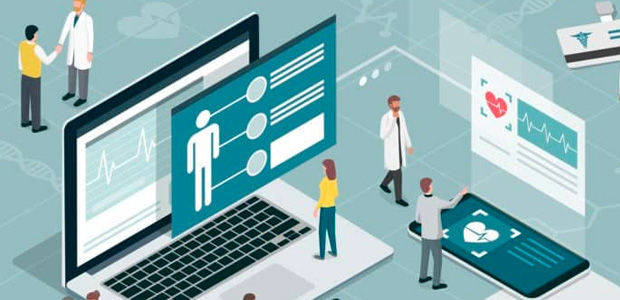EHR Systems + Medical Billing Integration
 Medical billing and practice management has long been a labor-intensive task for healthcare providers. There’s little doubt, however, that the use of EHR (Electronic Health Records) or sometimes known as EMR (Electronic Medical Records) has considerably slashed these tasks by offering providers a proven method to effectively streamline their processes.
Medical billing and practice management has long been a labor-intensive task for healthcare providers. There’s little doubt, however, that the use of EHR (Electronic Health Records) or sometimes known as EMR (Electronic Medical Records) has considerably slashed these tasks by offering providers a proven method to effectively streamline their processes.
According to the latest research, practically 90 percent of physicians assert that EHR is their principal need, and it pretty much governs their decision-making process when it comes to selecting a particular management style.
At present, medical billing is quite demanding but it can be made easier by incorporating the billing system with EHR. This integration of EHR and medical billing is a transformation that comes with a number of benefits.
Let’s have a brief look at how essential EHR systems are in the medical billing process.
Firstly, What Exactly is an EHR (Electronic Health Record)?
The purpose of EHR is to merge a patient’s medical chart into digital documents, creating updated patient records that can be retrieved in real time by authorized personnel in a digital format. They contain specifics of medical history, medications, allergies, radiology images, treatment plans and lab results of patients. In addition, they also offer healthcare providers a number of tools to help in making decisions about a patient’s care.
Eight Key Advantages of an EHR
- Provides wide-ranging information about the patient in a precise and up-to-date manner at the point-of-care.
- Securely shares electronic data with patients and various healthcare providers.
- Improves communication with the patients and providers as well as health care convenience.
- Provides safer and more dependable prescribing.
- Enhances privacy and security of patient information.
- Every patient record can be accessed in a speedy and secure manner.
- Helps suppliers improve productivity and work-life balance.
- Reduces prices through shortened work hours, enhanced safety, reduced duplication of testing and improved health.
EHR Increases Revenue
Every business has the goal of maximizing revenue. That’s also true of healthcare organizations. EHR offers billing and payment tools to help administer income and ensure payment. Claims can automatically be scrubbed of mistakes and coding errors, which might otherwise produce rejections. This feature boosts first-time acceptance rates for insurance claims, helping accelerate reimbursements, minus lost or delayed claims. EHR also allows providers to document every single facet of a patient’s visit, which makes it easier to deliver evidence about individual claims.
EHR Boosts Interoperability
To take part in federal incentive programs, clinics have to demonstrate the significant use of certified EHR technology. Improving patient care and data security includes keeping the data centralized by integrating billing solutions into EHR software.
External Interoperability
EHR billing integrations are highly interoperable and can be executed using HL7 standards. They include data that can be shared with the providers and practitioners that need to retrieve it. True, sensitive information remains confidential however, the gathered data may be used by third parties for improving the patient care process.
Internal Interoperability
Interoperability doesn’t mean just flawless communication between external programs. It can also be quite helpful for in-house software. Maintaining all data in one system can simplify the data management and claim filing process tremendously.
EHR billing integration cuts the number of data entry points, holding human errors to a minimum. A robust unified system thwarts breaches, meaning the provider has a lessened chance of headaches when it comes to working with sensitive patient information.
EHR Means Less Paperwork
When it comes to medical billing, paperwork is usually inescapable. However, it’s likely to reduce it with an integrated billing system. Minimizing paperwork can boost productivity, improve employee satisfaction and even have an effect on the operation’s bottom line.
Additionally, by removing paperwork from the equation, healthcare facilities can lower the number of human errors and speed up claim processing.
EHR Offers More Accurate Patient Information
First presented as an alternative to paper medical records, to make storing and retrieving data simpler, electronic files offer a variety of added benefits. For one, storing records electronically removes the chance of theft, misplacement, damage or revision of sensitive information. Plus, mistakes as a result of poor handwriting and legibility issues can be removed with digital records.
Physicians can bring patient information up to date in real time, allowing other healthcare providers a current, accurate patient file. This electronic record can connect other specialists involved in an individual patient’s healthcare. Continuity is quite helpful, particularly if a patient switches providers or visits a new physician as it offers physicians a comprehensive picture of the patient’s medical history, rather than expecting them to begin from scratch.
EHR Enhances Quality of Care
EHR helps to deliver better care for patients by allowing speedy access to patient records, bringing about more effective care. They also assist in more successful treatments while boosting the practice’s every-day functioning.
On the provider’s side, most EHR offers physicians health analytics that help identify patterns, forecast diagnosis and counsel on possible treatment decisions. Such analytics result in more positive patient results the first time around, instead of relying on antiquated trial-and-error methods.
On the patient’s side, they currently have admittance to patient portals, which provides access to historical medical data including lab and imaging outcomes, medications, diagnoses and much more. Patients can also communicate with their practitioners by sharing notes, swapping instant messages and even video conferencing.
Both provider and patients can use the portal to track an individual’s treatment progress. This also makes preventive care easier.
EHR Improves Patient Satisfaction
Improving patient satisfaction is one of the key goals on which healthcare providers focus. Automating the billing process and doing away with claim errors can help boost satisfaction rates for your patients.
By utilizing insurance eligibility verification software, a provider can obtain a clearer picture of which specific services are included in the patient’s insurance plan at the scheduling stage. A system ought to display insurance eligibility verification before a provider even initiates the billing process.
A quality EHR integrated billing system helps providers caution patients about probable unanticipated expenses related to insurance coverage, further boosting satisfaction levels.
EHR + Medical Billing Wrap-Up
Medical billing is a challenging process. The subtleties involved in filing claims, evading denials, tracking bills, coding and the like can be overpowering. Assigning the process to an integrated billing system can simplify the task enormously, letting providers focus on their core tasks.
By realizing an opportunity to submit insurance claims speedily and efficiently, providers can reduce rejections and denials while receiving their money as quick as possible. While they may already use a separate medical billing system, many providers desire a more comprehensive solution… an EHR solution.

